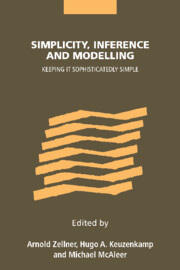Book contents
- Frontmatter
- Contents
- List of figures
- List of tables
- List of contributors
- 1 The enigma of simplicity
- PART I The importance of simplicity
- 2 What is the problem of simplicity?
- 3 Science seeks parsimony, not simplicity: searching for pattern in phenomena
- 4 A macroeconomic approach to complexity
- 5 The new science of simplicity
- 6 What explains complexity?
- 7 Occam's bonus
- PART II Simplicity in theory and practice
- Index
4 - A macroeconomic approach to complexity
Published online by Cambridge University Press: 22 September 2009
- Frontmatter
- Contents
- List of figures
- List of tables
- List of contributors
- 1 The enigma of simplicity
- PART I The importance of simplicity
- 2 What is the problem of simplicity?
- 3 Science seeks parsimony, not simplicity: searching for pattern in phenomena
- 4 A macroeconomic approach to complexity
- 5 The new science of simplicity
- 6 What explains complexity?
- 7 Occam's bonus
- PART II Simplicity in theory and practice
- Index
Summary
Introduction: the problem of complexity
complexity, correctly viewed, is only a mask for simplicity
(Simon, 1969, p. 1)An economy is a complex system, in the sense that it is a system made up of a large number of parts that interact in a non-simple way (see Simon, 1962, p. 468). The Walrasian programme was an answer to this problem of complexity by setting up a manageable interdependent system of a whole economy. A modern version of this programme is the Cowles approach: a combination of the Walrasian method to construct a mathematical system without empirical content and econometrics to put empirical flesh and blood on this system. The Cowles method to treat complexity was to build more and more comprehensive models.
This development was not justified by its results, more comprehensiveness did not lead to better predictions than very simple univariate naive models (e.g. random walks, low-order autoregressive (AR) models, or simple autoregressive moving average (ARMA) models; see Zellner, 1994 for a brief survey). In interpreting these results, Milton Friedman (1951), who was influential in having such forecasting tests performed, suggested that the Cowles programme of building large scale macroeconomic models was probably faulty and needed reformulation. He saw the disappointing test results as evidence of the prematurity of macromodelling of a whole economy, which sent him in another research direction, namely that of partitioning.
- Type
- Chapter
- Information
- Simplicity, Inference and ModellingKeeping it Sophisticatedly Simple, pp. 73 - 82Publisher: Cambridge University PressPrint publication year: 2002



